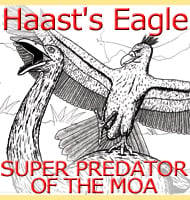In Depth
When originally found, the fossils of the Wood Harrier (Circus dossenus) were thought to be those of an Accipiter, a bird that belongs to the group more commonly known as goshawks and sparrowhawks.
This was mainly because the bones and wing proportions seemed to match up best with the Accipiters, but further study into the remains led to the 1991 conclusion that the bone actually belonged to a harrier.
Assigned as a species to the Circus genus, C. dosseus has since become known as the Wood Harrier, and occasionally the Mime harrier.
The dossenus name means jester, which is both a play on words with the genus name of Circus, and the fact that the describers were ‘fooled’ into thinking that the bones were of an Accipter.
The Wood Harrier is a likely example of insular dwarfism, the biological phenomenon where animals become smaller as not to exhaust limited food sources.
Harriers did not develop independently upon Hawaii, so it is likely that the ancestors of the Wood Harrier flew to the Hawaiian Islands and then settled, with successive generations becoming smaller.
This seems quite plausible since in modern times another species of harrier named C. cyaneus (a.k.a. the Hen Harrier and the Northern Harrier) is occasionally sighted around the Hawaiian Islands, and though this may not be the ancestor to the Wood Harrier, it establishes the precedent that harriers from other locations can reach the Hawaiian Islands.
On a side note, other species of harrier are known to have colonised several islands in the Pacific, with a good example being the Swamp Harrier (C. approximans) being known in Australia, Fiji, Vanuatru, New Caledonia and New Zealand.
The Wood Harrier appears to have been one of the smallest harrier species, though aside from just growing smaller, the wings changed in proportion so that became shorter and more in proportion to the wings of an Accipiter.
This is an indicator that the Wood Harrier adapted to a different mode of hunting and ecological niche than that occupied by other harriers.
This is because harriers usually have long wings that enable them to soar high over open spaces so that they can then dive down on to ground dwelling animals such as reptiles, lizards, snakes, small mammals, etc.
The Hawaiian Islands however were a product of volcanic activity, which means that they rose up out of the Pacific Ocean while remaining isolated from other land masses.
By being isolated, vertebrate animals could only fly or swim there, and given their distance from the continents where mammals dominated the land, only birds could make it there.
In addition, the lack of grazing animals meant that the islands were covered in forests with very little in the way of open spaces, so the Hawaiian Islands had neither the habitat nor the prey animals that harriers were best suited to hunting.
In order to survive, the first harriers had to change. By developing proportionately shorter wings, Wood Harrier were better able to fly through the forests without brushing the edges of their wings against branches and trunks.
In addition to this, the Wood Harrier likely had to adapt to hunting the other birds of the Hawaiian Islands given the lack of other prey animals that other harriers of the world hunted.
Some of these birds would have been secondarily flightless (evolved from flying ancestors but losing the ability to fly over successive generations), and it’s possible but not yet known for certain, that Wood Harriers may have focused their attacks upon these.
An alternative would be Wood Harriers learning to attack other birds while on the wing, and yet another alternative would be Wood Harriers learning to catch and eat insects, which some birds of prey like some falcons are known to do (Falco subbuteo being one example).
Unfortunately as with so many Pacific Island animals (though continents are no exceptions either), the Wood Harrier seems to have gone extinct as a direct result of the first people arriving upon the islands.
The two factors that likely affected the Wood Harrier the most here was a combination of habitat loss through clearing as well as the introduction of Rattus exulans, better known as the Polynesian rat and Pacific rat.
Harriers are known to nest on the ground, and so far there is no evidence to doubt this mode of nesting for the Wood Harrier.
This means that both eggs and chicks would have been prey to the rats, which are blamed for wiping out many species of Hawaiian birds.
With less and less young surviving to adulthood, and a reduction in prey species, Wood Harriers simply could not survive.
The harriers are a versatile group of birds of prey, and while the small Wood Harrier was flying through the forests of Oahu and Molokai, the Eyles’ Harrier of New Zealand grew up to be one of the largest harriers ever known.
Further Reading
- Descriptions of thirty-two new Species of Birds from the Hawaiian Islands - Stors L. Olson & Helen F. James - 1991 (ISBN 0-935868-54-2).









